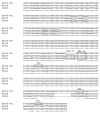A Role of Sp1 Binding Motifs in Basal and Large T-Antigen-Induced Promoter Activities of Human Polyomavirus HPyV9 and Its Variant UF-1
- PMID: 29135936
- PMCID: PMC5713382
- DOI: 10.3390/ijms18112414
A Role of Sp1 Binding Motifs in Basal and Large T-Antigen-Induced Promoter Activities of Human Polyomavirus HPyV9 and Its Variant UF-1
Abstract
Human polyomavirus 9 (HPyV9) was originally detected in the serum of a renal transplant patient. Seroepidemiological studies showed that ~20-50% of the human population have antibodies against this virus. HPyV9 has not yet been associated with any disease and little is known about the route of infection, transmission, host cell tropism, and genomic variability in circulating strains. Recently, the HPyV9 variant UF-1 with an eight base-pair deletion, a thirteen base-pair insertion and with point mutations, creating three putative Sp1 binding sites in the late promoter was isolated from an AIDS patient. Transient transfection studies with a luciferase reporter plasmid driven by HPyV9 or UF1 promoter demonstrated that UF1 early and late promoters were stronger than HPyV9 promoters in most cell lines, and that the UF1 late promoter was more potently activated by HPyV9 large T-antigen (LTAg). Mutation of two Sp1 motifs strongly reduced trans-activation of the late UF1 promoter by HPyV9 LTAg in HeLa cells. In conclusion, the mutations in the UF1 late promoter seem to strengthen its activity and its response to stimulation by HPyV9 LTAg in certain cells. It remains to be investigated whether these promoter changes have an influence on virus replication and affect the possible pathogenic properties of the virus.
Keywords: Sp1; large T antigen; luciferase; mutation; non-coding control region.
Conflict of interest statement
The authors declare no conflict of interest.
Figures





Similar articles
-
Imperfect Symmetry of Sp1 and Core Promoter Sequences Regulates Early and Late Virus Gene Expression of the Bidirectional BK Polyomavirus Noncoding Control Region.J Virol. 2016 Oct 28;90(22):10083-10101. doi: 10.1128/JVI.01008-16. Print 2016 Nov 15. J Virol. 2016. PMID: 27581987 Free PMC article.
-
Novel Human Polyomavirus Noncoding Control Regions Differ in Bidirectional Gene Expression according to Host Cell, Large T-Antigen Expression, and Clinically Occurring Rearrangements.J Virol. 2018 Mar 14;92(7):e02231-17. doi: 10.1128/JVI.02231-17. Print 2018 Apr 1. J Virol. 2018. PMID: 29343574 Free PMC article.
-
Complete genomic sequence of a new Human polyomavirus 9 strain with an altered noncoding control region.Virus Genes. 2014 Dec;49(3):490-2. doi: 10.1007/s11262-014-1119-z. Epub 2014 Sep 27. Virus Genes. 2014. PMID: 25260554
-
Simian virus 40 large T-antigen, but not small T-antigen, trans-activates the human cytomegalovirus major immediate early promoter.Virus Genes. 2001;23(2):215-26. doi: 10.1023/a:1011877112214. Virus Genes. 2001. PMID: 11724277
-
Prevalence and in vitro study of human polyomavirus 9.Sci Rep. 2024 Nov 26;14(1):29313. doi: 10.1038/s41598-024-80806-3. Sci Rep. 2024. PMID: 39592793 Free PMC article.
Cited by
-
Genetic Diversity of the Noncoding Control Region of the Novel Human Polyomaviruses.Viruses. 2020 Dec 7;12(12):1406. doi: 10.3390/v12121406. Viruses. 2020. PMID: 33297530 Free PMC article. Review.
-
Human Polyomaviruses and Papillomaviruses.Int J Mol Sci. 2018 Aug 10;19(8):2360. doi: 10.3390/ijms19082360. Int J Mol Sci. 2018. PMID: 30103449 Free PMC article. No abstract available.
-
Promoter activity of Merkel cell Polyomavirus variants in human dermal fibroblasts and a Merkel cell carcinoma cell line.Virol J. 2020 Apr 19;17(1):54. doi: 10.1186/s12985-020-01317-x. Virol J. 2020. PMID: 32306957 Free PMC article.
References
MeSH terms
Substances
LinkOut - more resources
Full Text Sources
Other Literature Sources

